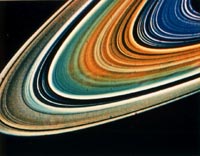Astronomers spot new ring around Saturn
Saturn has another, very diffuse, outer ring identified by astronomers working on the Cassini imaging data at NASA's JPL laboratory and the Space Science Institute in Boulder.

The ring showed up in a photograph taken on 17 September, in what scientists are calling a "one of a kind" observation.
Cassini's cameras can't look towards the sun, except during so-called occulations, when the planet passes between the sun and the spacecraft. These occultations generally only last for around an hour, leaving little time for observation work. But on 17 September, Cassini found itself flying in Saturn's shadow for 12 hours, reports The Register.
Mission scientists found the new ring at the same orbital distance as Saturn's moons Janus and Epimetheus, which measure 194 and 138 kilometres across, respectively. That location suggests they may be the source of the ring's material.
However, the moons are too small to have volcanic activity that could spew material into space the way Saturn's 512-kilometre-wide moon Enceladus does, says Cassini science team member Mark Showalter of the SETI Institute in Mountain View, California, US.
"When an object is that small, it's basically a dead ice ball," he told New Scientist. "There really can't be much going on except the shooting gallery out there of meteoroids and little comets."
"Both the new ring and the unexpected structures in the E ring should provide us with important insights into how moons can both release small particles and sculpt their local environments," said Matt Hedman, a research associate working with team member Joseph Burns, an expert in diffuse rings, at Cornell University in Ithaca, New York.
In the latest observations, scientists once again see the bright ghost-like spokes - transient, dusty, radial structures -streaking across the middle of Saturn's main rings.
Capping off the new batch of observations, Cassini cast its powerful eyes in our direction and captured Earth, a pale blue orb, and a faint suggestion of our moon. Not since NASA's Voyager 1 spacecraft saw Earth as a pale blue dot from beyond the orbit of Neptune has Earth been imaged in color from the outer solar system.
"Nothing has greater power to alter our perspective of ourselves and our place in the cosmos than these images of Earth we collect from faraway places like Saturn," said Carolyn Porco, Cassini imaging team leader at the Space Science Institute in Boulder, Colorado. Porco was one of the Voyager imaging scientists involved in taking the 'Pale Blue Dot' image, according to Cosmoc Online.
Subscribe to Pravda.Ru Telegram channel, Facebook, RSS!


